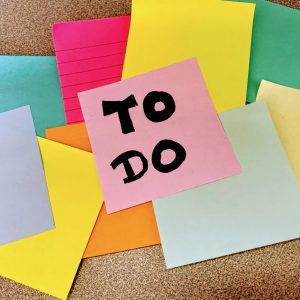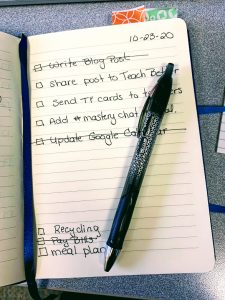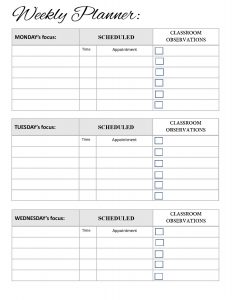TL;DR:
- Many people find their to-do lists turning into a pile of sticky notes. Go beyond sticky notes to keep track of your to-do lists.
- Schedule your events in Google Calendar, keep a notebook close by, and set alarms for reminders.
- This post includes an example of an organizer to use for managing your tasks.
In March 2020, the lines between work and home blurred more than usual. We’ve all heard the stories of the teacher who brings home their work bag EVERY night. Most of the time this bag is filled with papers that need to be graded, journals to read and respond to, and teacher’s manuals used for planning upcoming lessons—to-do lists that never end!
The bringing back and forth of the school bag has almost become synonymous with being a teacher. This is built into a teacher’s routine. It becomes such a habit that they do it EVERY night. And they do it even when some of those nights they’re too exhausted to open up the bag and tackle the extra work brought home.
Whatever system you choose, make sure you’re consistent with it. Reflect on the use of your time each day and make sure to include the end of your workday. Share on XWorking From Home
When the Coronavirus closed our schools, we began to work from home. Our living rooms, dining rooms, spare rooms, and any other nook we could find became our offices or classrooms. We would wake up and start working.
For most of us, that meant being on Zoom all day while we figured out how we were going to teach in the virtual world. The day consumed our time with learning new technologies and reaching out to students and families. It consumed our time with consulting colleagues with guidance on families we were worried about and helping with lunch distribution. It involved attending even more virtual meetings and attending all the free webinars that would help us learn what we could to continue being the best teachers for students during this time.
Our schedules and routines became a thing of the past.
For me, this was the most difficult. I didn’t have the exact time I needed to wake up and get out of the house to get to school. I didn’t have different bells and times at school to tell me it was time for a snack, to quickly eat my lunch, or head home for the day before my family came looking for me.
It was too easy to turn on my computer first thing and dive into my day. I also found myself logging in to check and respond to email after dinner and get so consumed it would be late at night before I would shut down.
How did this change impact you and your family? What have you found to help you manage your time and organize your to-do lists?
I have found that having a system that works for YOU is most important.
I’ve tried several different ideas, templates, and planners that have been recommended in order to figure out what would work best for me.
Let’s start with calendars—I don’t know about you, but I’m a complete Google Calendar girl now! (I won’t even get into the issue with work using Outlook calendar now.) I schedule EVERYTHING. As the saying goes, “if it’s on the calendar, it gets done; if it’s not on the calendar, it won’t get done.”
I schedule my meetings, class visits, observations, and even tasks I want to complete. A hint someone told me recently was that he adds the task on the calendar and has it repeat daily until he finishes it. I need to try this. I will add a task to my calendar but if something happens and I don’t get to it, I would have to add time to do it another day. By having it repeat daily, it is a visual reminder every day to get it done. I actually color code my calendar too which really helps visually with the type of appointment and prioritizing events.
The best part of Google Calendar is having it wherever I go. It’s also really easy to invite others and the integration with Google Meets made setting up my virtual meetings that much smoother this spring.
How do you keep track of your growing to-do lists?
This has evolved for me over time in a few different ways. This is the one thing I have not been able to go digital with yet. I’ve tried the reminders, tasks, apps for to-dos, as well as Google Keep.
None of these work for me as well as the pile of sticky notes or scrap paper on my desk!
I’ve learned to tame these by keeping a notebook close by. I have one section for the to do’s and another for ‘notes’. The notes can be from phone calls or conversations with others and sometimes these result in more tasks to add to my to-do section.
The strategy for keeping track of my to-do lists came from Becky Higgins who inspires others in Cultivating a Good Life.

I like to draw a box—or you can make a dot, dash, or arrow—then I write the to-do.
At the top of the page, I write all the to-dos for work, and then starting at the bottom I also include any of my to-dos for home (because those are the ones I usually forget the most).
Here’s the thing, you don’t just keep adding and adding to your list. You re-write the list onto a clean sheet the next day. This helps you focus on those tasks and even re-prioritize what you want to get accomplished. Add a few highlights to those high priority items. Once you complete the task, simply draw a line through it.
I also like to use a template from Melinda Miller to organize my to-do lists.

I will often quickly fill this out to start my day. It has a place for any meetings I have scheduled. There’s a task list and I only add the tasks that I will set time aside to work on that day. I have a section for any classroom visits that day.
This has really helped me make sure that I’m getting into classrooms every day. I feel successful when I get to check off the rooms that I have visited that day. Finally, there are sections for any phone calls with parents or student situations that I have dealt with.
This gives me a quick snapshot at the beginning of the day so I can plan how I’m going to use my time, as well as a reflection at the end of the day about how my day actually went, and where I spent most of my time, especially if it wasn’t where I had planned to spend it.
The last strategy I want to share with you is using the alarm app on your phone.
Do you ever get busy with a task or issue or just lost in concentration and then realize you were supposed to do the end of the day announcements five minutes ago? I have an alarm for that!
I set alarms on my phone for daily or weekly reminders to help keep me on track. The alarm goes off five minutes before some of my ‘duties’ and this makes me aware that I either need to prepare for the duty or to get someone to cover the duty/task for me. There’s nothing worse than a cafeteria full of kids waiting for me to arrive for my scheduled time to help supervise.
[scroll down to keep reading]
When managing your to-do lists, the important thing to remember is that you have to find what works for you.
You may prefer to use a planner and write in pencil so you can adjust as needed. That pile of sticky notes reminding you of the tasks you want to finish may be the best way for you to get them done. (It worked for me for a long time). Whatever system you choose, make sure you’re consistent with it. Reflect on the use of your time each day and make sure to include the end of your workday.
Whenever you have multiple errands to run, group them together and figure out the most efficient way to get them done. For example, when I am at school, I have a basket of errands or tasks that require me to leave my classroom. Once I have a stack of things to do, I think about the most efficient route around the building to get all of my tasks done.
Another example of this, is my father was an elementary principal and found the quickest route from his school building to the district office by trying to take all right turns (which take up much less time than left turns). His priority was to his staff and students and by managing his errands more efficiently, he was able to devote more time to his school building and their needs. By grouping tasks together you are much more efficient and have time to give back to yourself and your students! – Jennifer Appel, Middle School Educator, Chief Heart Officer for Teach Better Team (@jennifermappel)
See the full Time Management 101 blog series here!
About Bobbie French
Bobbie French is an educational leader, presenter and writer from Massachusetts.
Bobbie has been an educator for over 24 years. She has been an elementary guidance counselor, classroom teacher, special education coordinator, Title I Director, Preschool Director and Administrator.
Bobbie is passionate about focusing on the whole child and creating an environment where all students have a sense of belonging. She appreciates and recognizes the hard work of teachers, and is committed to supporting others to be their best for kids every day. Her passion and enthusiasm for creating a positive and engaging school culture is contagious.
Bobbie is also an avid photographer and loves to tell her school’s story.



